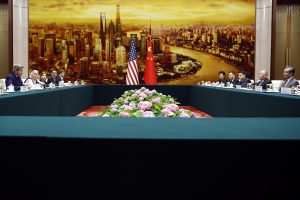After Nancy Pelosi visited Taiwan in August 2022, U.S.-China climate conversations were frozen. This changed with U.S. Climate Envoy John Kerry’s recent visit to Beijing.
Chinese leader Xi Jinping has maintained his stance that China will dictate its own pace for climate action. At the same time Kerry was speaking to officials in Beijing, Xi spoke at a conference on ecological and environmental protection, stating “the path, method, pace and intensity to achieve this goal should and must be determined by ourselves, and will never be influenced by others.”
The bottom line is simple: China’s domestic climate agenda is set and executed by China and China only.
The readouts from both sides following Kerry’s visit indicated a series of productive conversations, but the trip failed to deliver any solid outcomes. There was no joint statement, no commitment to resume the “Working Group on Enhancing Climate Action in the 2020s,” and no progress was made on the methane or coal agendas.
It appears that both countries, at this stage, are more inclined to continue progressing their own domestic climate agendas even as cooperation remains stalled. While dialogues are important to keep open lines of communication and signal to the international community the responsibility both countries have to advance the climate agenda, they fail to take actionable steps toward climate adaptation and mitigation.
It’s promising, however, that each side is making progress domestically.
A Track Record of Domestic Headway
In 2022, the U.S. passed the Inflation Reduction Act, the largest piece of legislation dedicated to climate and energy in U.S. history. The act aims to drive uptake in the clean energy transition by offering tax credits and subsidies across wind, hydro, solar, geothermal, and nuclear energy.
China’s 14th Five-Year Plan, meanwhile, reiterated the previously announced target of achieving carbon neutrality by 2060 and set a goal of seeing emissions peak in 2030. It also builds upon Beijing’s existing advancement in the clean energy transition. China has also encouraged the judges of top courts to hear climate-related cases and weigh carbon impacts in their decisions to help the country achieve its emission reduction goals.
Xi recently reinforced the need to accelerate the construction of a power system that is “green and low-carbon, secure and abundant, economically efficient, flexible, and intelligent in supply and demand coordination.” In addition, China is on track to double its utility-scale solar and wind power capacity and shatter the central government’s ambitious 2030 target of 1,200 gigawatts (GW) five years ahead of schedule.
How Can We Set Realistic International Goals Given This Domestic First Success?
As we approach the 2023 United Nations Climate Change Conference (COP28), to be held in Dubai in December, the international community will once again look at the Nationally Determined Contributions (NDCs) of member nations in addition to completing a Global Stocktake. Both of these measures are inherently domestically driven and are emblematic of what a particular country can commit to doing at a sustainable pace. As the world’s two largest emitters, the U.S. and China will receive special attention.
At these meetings, both countries will not be presenting their collaborations, but rather, their own plans to meet the targets set out by the international community. Both countries’ relative success is a sign that the international community should let this continue.
Both sides are well aware of the current climate emergency. Excluding cooperation that takes the form of clean technology transfers, joint grain storage, or loss and damage financing, domestic climate agendas appear better suited to ensure positive results for the climate — and that’s the main thing.
Cooperation and competition are both relative frames that focus on the relationship between the two countries, tempering the urgency of making climate progress immediately, by whatever means necessary. Cooperation would be beneficial — and competition stands to inspire rapid action in some areas.
But the best solution may be the simplest: Coexistence.
Performing bilateral cooperation on climate change could help mend the severe wounds in the U.S.-China relationship, but the fastest way to avoid the worst effects of climate change may be to just allow each side to do what it is motivated to do at home and through international fora, rather than advance bilateral cooperation for cooperation’s sake.

































